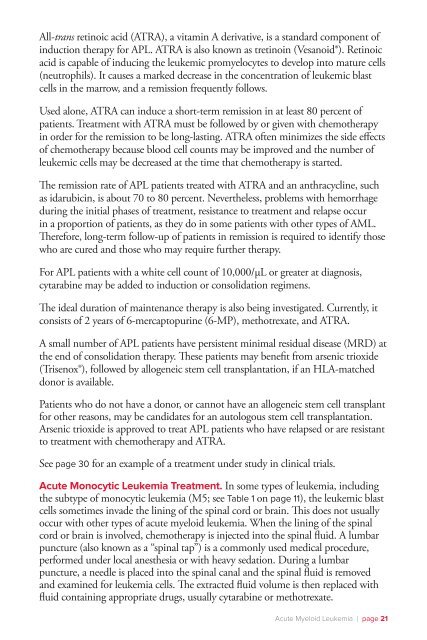Acute Myeloid Leukemia - The Leukemia & Lymphoma Society
Acute Myeloid Leukemia - The Leukemia & Lymphoma Society
Acute Myeloid Leukemia - The Leukemia & Lymphoma Society
- No tags were found...
You also want an ePaper? Increase the reach of your titles
YUMPU automatically turns print PDFs into web optimized ePapers that Google loves.
All-trans retinoic acid (ATRA), a vitamin A derivative, is a standard component ofinduction therapy for APL. ATRA is also known as tretinoin (Vesanoid®). Retinoicacid is capable of inducing the leukemic promyelocytes to develop into mature cells(neutrophils). It causes a marked decrease in the concentration of leukemic blastcells in the marrow, and a remission frequently follows.Used alone, ATRA can induce a short-term remission in at least 80 percent ofpatients. Treatment with ATRA must be followed by or given with chemotherapyin order for the remission to be long-lasting. ATRA often minimizes the side effectsof chemotherapy because blood cell counts may be improved and the number ofleukemic cells may be decreased at the time that chemotherapy is started.<strong>The</strong> remission rate of APL patients treated with ATRA and an anthracycline, suchas idarubicin, is about 70 to 80 percent. Nevertheless, problems with hemorrhageduring the initial phases of treatment, resistance to treatment and relapse occurin a proportion of patients, as they do in some patients with other types of AML.<strong>The</strong>refore, long-term follow-up of patients in remission is required to identify thosewho are cured and those who may require further therapy.For APL patients with a white cell count of 10,000/μL or greater at diagnosis,cytarabine may be added to induction or consolidation regimens.<strong>The</strong> ideal duration of maintenance therapy is also being investigated. Currently, itconsists of 2 years of 6-mercaptopurine (6-MP), methotrexate, and ATRA.A small number of APL patients have persistent minimal residual disease (MRD) atthe end of consolidation therapy. <strong>The</strong>se patients may benefit from arsenic trioxide(Trisenox®), followed by allogeneic stem cell transplantation, if an HLA-matcheddonor is available.Patients who do not have a donor, or cannot have an allogeneic stem cell transplantfor other reasons, may be candidates for an autologous stem cell transplantation.Arsenic trioxide is approved to treat APL patients who have relapsed or are resistantto treatment with chemotherapy and ATRA.See page 30 for an example of a treatment under study in clinical trials.<strong>Acute</strong> Monocytic <strong>Leukemia</strong> Treatment. In some types of leukemia, includingthe subtype of monocytic leukemia (M5; see Table 1 on page 11), the leukemic blastcells sometimes invade the lining of the spinal cord or brain. This does not usuallyoccur with other types of acute myeloid leukemia. When the lining of the spinalcord or brain is involved, chemotherapy is injected into the spinal fluid. A lumbarpuncture (also known as a “spinal tap”) is a commonly used medical procedure,performed under local anesthesia or with heavy sedation. During a lumbarpuncture, a needle is placed into the spinal canal and the spinal fluid is removedand examined for leukemia cells. <strong>The</strong> extracted fluid volume is then replaced withfluid containing appropriate drugs, usually cytarabine or methotrexate.<strong>Acute</strong> <strong>Myeloid</strong> <strong>Leukemia</strong> I page 21
















